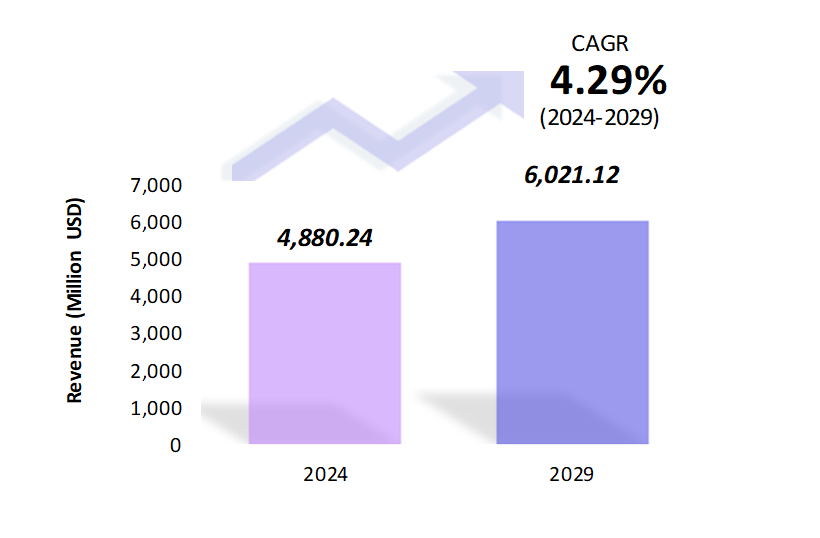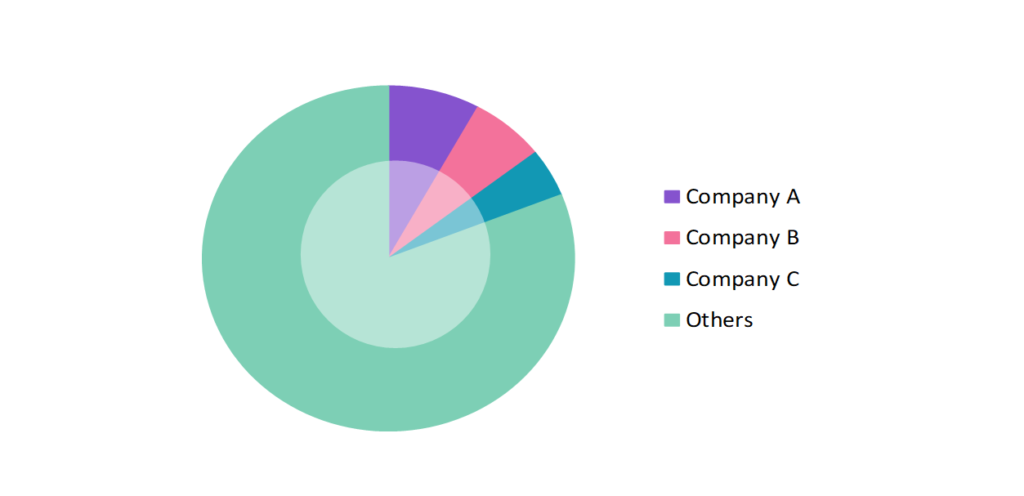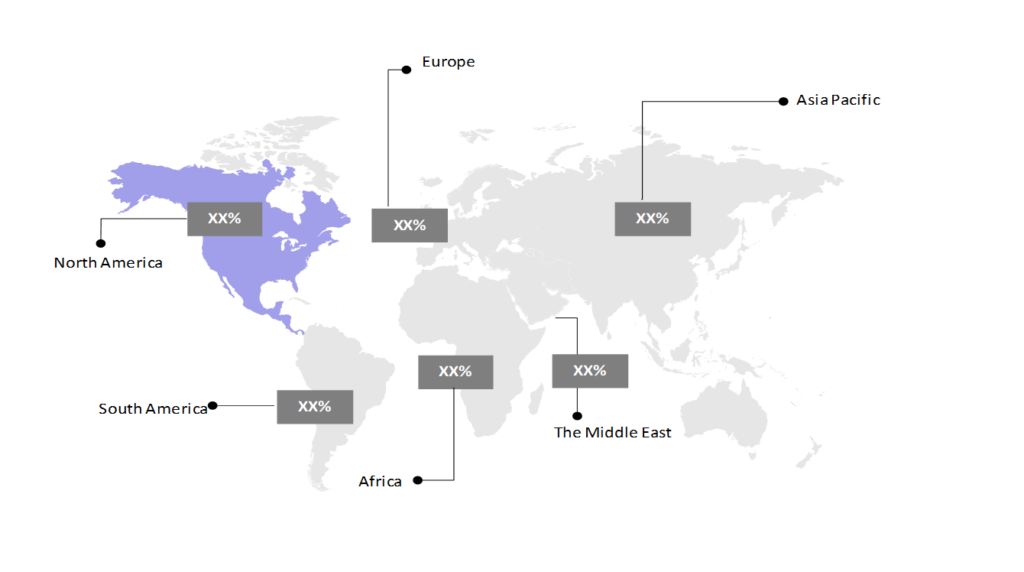Engine Oil Pan Market: Size, Share, Trends & Forecast (2024-2029)
The market report offers a detailed analysis segmented by Material (Steel, Aluminum, Others); by Product Type (Structural Oil Pan, Non-Structural Oil Pan); by Vehicle Type (Two-Wheeler, Passenger Vehicle, Light Commercial Vehicle, Trucks, Buses & Coaches, Off-road Vehicles); by Sales Channel (OEMs, Aftermarket); by Geography (North America, South America, Asia Pacific, Europe, the Middle East, Africa).
Outlook

- The engine oil pan market is estimated to be at USD 4,880.24 Mn in 2024 and is anticipated to reach USD 6,021.12 Mn in 2029.
- The engine oil pan market is registering a CAGR of 4.29% during the forecast period of 2024-2029.
- The engine oil pan market is experiencing steady growth, driven by increasing vehicle production and the shift toward lightweight, fuel-efficient components. Demand is bolstered by the thriving automotive aftermarket, particularly in developing regions where older vehicles require frequent part replacements.
Request a free sample.
Ecosystem

- The participants in the global engine oil pan industry are always developing their strategies to preserve a competitive advantage.
- Leading companies are focusing on innovation, particularly in lightweight materials and integrated technologies, to differentiate themselves and meet evolving industry demands.
- Several important entities in the engine oil pan market include Mahle Group; Dana Inc.; American Axle & Manufacturing Holdings Inc.; Polytec Group; Magna International, Inc.; and others.
Ask for customization.
Findings
| Attributes | Values |
|---|---|
| Historical Period | 2018-2022 |
| Base Year | 2023 |
| Forecast Period | 2024-2029 |
| Market Size (2024) | USD 4,880.24 Mn |
| Market Size (2029) | USD 6,021.12 Mn |
| Growth Rate | 4.29% CAGR from 2024 to 2029 |
| Key Segments | Material (Steel, Aluminum, Others); Product Type (Structural Oil, Pan, Non- Structural, Oil Pan); Vehicle Type (Two Wheeler, Passenger Vehicle, Light Commercial Vehicle, Trucks, Buses & Coaches, Off- road Vehicles); Sales Channel (OEMs, Aftermarket); Geography (North America, South America, Asia Pacific, Europe, the Middle East, Africa) |
| Key Vendors | Mahle Group; Dana Inc.; American Axle & Manufacturing Holdings Inc.; Polytec Group; Magna International, Inc. |
| Key Countries | The U.S; Canada; Mexico; Brazil; Argentina; Colombia; Chile; China; India; Japan; South Korea; The UK; Germany; Italy; France; Spain; Turkey; UAE; Saudi Arabia; Egypt; South Africa |
| Largest Market | North America |
Get a free quote.
Trends
- Shift Towards the Use of Lightweight Materials: With the automotive industry prioritizing fuel efficiency and emissions reduction, there is a shift towards the use of lightweight materials like aluminum and composites in engine oil pans. These materials offer the dual benefits of reducing overall vehicle weight and enhancing fuel economy, making them increasingly popular in both OEM and aftermarket applications. For instance, automakers like Ford and BMW are incorporating aluminum oil pans into their newer models to meet stringent environmental regulations.
- Growing Popularity of Modular Engine Designs: The trend towards modular engine designs is influencing the engine oil pan market, with manufacturers developing more adaptable and customizable oil pans. These modular pans can be easily configured to fit various engine types, offering greater flexibility in design and assembly.
- Integration of Advanced Technologies: The automotive industry’s movement towards smart and connected vehicles is directing the development of oil pans equipped with advanced sensors and diagnostic capabilities. These high-tech oil pans can monitor oil levels, temperature, and quality in real time, providing critical data to both drivers and service centers. Automakers like Mercedes-Benz are integrating such technology into their premium models, setting a trend for future vehicles.
Speak to analyst.
Catalysts
- Automotive Production Growth: The global automotive industry continues to grow, particularly in emerging markets like China and India, where vehicle production and sales are booming. This growth directly translates to increased demand for engine oil pans, boosting market revenue for both OEMs and aftermarket suppliers.
- Stringent Fuel Efficiency Regulations: Governments around the world are implementing more rigorous fuel efficiency standards, compelling automakers to seek innovative ways to reduce vehicle weight. This regulatory pressure is driving the adoption of lightweight engine oil pans, which contribute to improved fuel economy. The European Union’s CO2 emission targets, for instance, are pushing automakers to integrate lighter components, thereby increasing the demand for aluminum and composite oil pans.
- Aftermarket Sales: The expanding automotive aftermarket in developing regions is boosting the engine oil pan market. In countries like Brazil and Mexico, where vehicle ownership is rising and older vehicles are kept longer, the consistent demand for replacement parts, including oil pan is increasing.
Inquire before buying.
Restraints
- High Production Costs: The transition to lightweight materials like aluminum and composites for engine oil pans involves higher production costs due to the need for specialized manufacturing processes and raw materials. These increased costs can squeeze profit margins for manufacturers, particularly in a highly competitive market.
- Market Saturation: In mature automotive markets, particularly in North America and Europe, the engine oil pan market is nearing saturation, limiting growth opportunities for established players. As most vehicles already incorporate advanced components, the replacement market is becoming the primary revenue source, which can be unpredictable and less profitable. Companies operating in these regions are finding it challenging to achieve significant growth without expanding into new markets.
- Increasing Use of Electric Vehicles: The rise of electric vehicles presents a significant challenge to the traditional engine oil pan market, as EVs eliminate the need for conventional internal combustion engine components. Manufacturers who specialize in producing oil pans for traditional vehicles face the risk of technological obsolescence if they do not adapt to the evolving market. This shift is forcing companies to either innovate or diversify their product offerings to stay relevant in a rapidly changing industry.
Personalize this research.
Hotspot

Explore purchase options.
Table of Contents
| 1. Introduction 1.1. Research Methodology 1.2. Scope of the Study 2. Market Overview / Executive Summary 2.1. Global Engine Oil Pan Market (2018 – 2022) 2.2. Global Engine Oil Pan Market (2023 – 2029) 3. Market Segmentation 3.1. Global Engine Oil Pan Market by Material 3.1.1. Steel 3.1.2. Aluminium 3.1.3. Others 3.2. Global Engine Oil Pan Market by Product Type 3.2.1. Structural Oil 3.2.2. Pan 3.2.3. Non- Structural 3.2.4. Oil Pan 3.3. Global Engine Oil Pan Market by Vehicle Type 3.3.1. Two-Wheeler 3.3.2. Passenger Vehicle 3.3.3. Light Commercial Vehicle 3.3.4. Trucks 3.3.5. Buses & Coaches 3.3.6. Off-road Vehicles 3.4. Global Engine Oil Pan Market by Sales Channel 3.4.1. OEMs 3.4.2. Aftermarket 4. Regional Segmentation 4.1. North America 4.1.1. The US 4.1.2. Canada 4.1.3. Mexico 4.2. South America 4.2.1. Brazil 4.2.2. Argentina 4.2.3. Colombia 4.2.4. Chile 4.2.5. Rest of South America 4.3. Asia Pacific 4.3.1. China 4.3.2. India 4.3.3. Japan 4.3.4. South Korea 4.3.5. Rest of Asia Pacific 4.4. Europe 4.4.1. The UK 4.4.2. Germany 4.4.3. Italy 4.4.4. France 4.4.5. Spain 4.4.6. Rest of Europe 4.5. The Middle East 4.5.1. Turkey 4.5.2. UAE 4.5.3. Saudi Arabia 4.5.4. Rest of the Middle East 4.6. Africa 4.6.1. Egypt 4.6.2. South Africa 4.6.3. Rest of Africa 5. Value Chain Analysis of the Global Engine Oil Pan Market 6. Porter Five Forces Analysis 6.1. Threats of New Entrants 6.2. Threats of Substitutes 6.3. Bargaining Power of Buyers 6.4. Bargaining Power of Suppliers 6.5. Competition in the Industry 7. Trends, Drivers and Challenges Analysis 7.1. Market Trends 7.1.1. Market Trend 1 7.1.2. Market Trend 2 7.1.3. Market Trend 3 7.2. Market Drivers 7.2.1. Market Driver 1 7.2.2. Market Driver 2 7.2.3. Market Driver 3 7.3. Market Challenges 7.3.1. Market Challenge 1 7.3.2. Market Challenge 2 7.3.3. Market Challenge 3 8. Opportunities Analysis 8.1. Market Opportunity 1 8.2. Market Opportunity 2 8.3. Market Opportunity 3 9. Competitive Landscape 9.1. Mahle Group 9.2. Dana Inc. 9.3. American Axle & Manufacturing Holdings Inc. 9.4. Polytec Group 9.5. Magna International, Inc. 9.6. Company 6 9.7. Company 7 9.8. Company 8 9.9. Company 9 9.10. Company 10 |
Know the research methodology.
Engine Oil Pan Market – FAQs
1. What is the current size of the engine oil pan market?
Ans. In 2024, the engine oil pan market size is $4,880.24 Mn.
2. Who are the major vendors in the engine oil pan market?
Ans. The major vendors in the engine oil pan market are Mahle Group; Dana Inc.; American Axle & Manufacturing Holdings Inc.; Polytec Group; Magna International, Inc.
3. Which segments are covered under the engine oil pan market segments analysis?
Ans. The engine oil pan market report offers in-depth insights into Material, Product Type, Vehicle Type, Sales Channel, and Geography.
